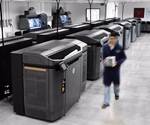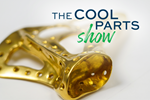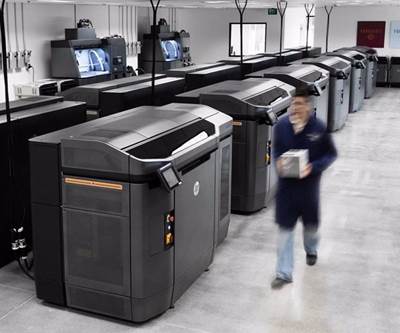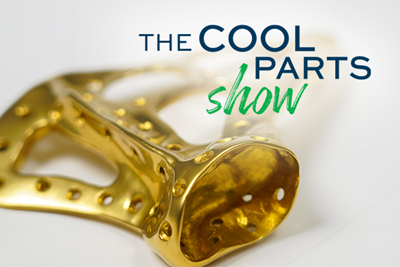Share
Read Next
A promise of additive manufacturing is mass customization, or production in which every piece is tailored to a separate recipient. Manufacturing that is entirely digital and free of fixed tooling means every piece can be different without the pace of production breaking stride. I recently had a chance to visit and see in action one of the most established and successful applications of mass customization via AM: 3D Systems’ surgical guide production operation in Littleton, Colorado. While “custom” in this case is not the preferred word — more on that in a moment — the operation has a lot to say about the daily reality and the way ahead for a possibility we have only begun to explore: tailor-made production with 3D printing.

The 3D Systems Littleton facility is one of the largest laser powder bed fusion production sites in the world, at more than 40 machines. They run in multiple rooms on this site, one of which is seen here. Source: 3D Systems
The 3D printed surgical guides are generally made of titanium via laser powder bed fusion (LPBF), and used mostly for maxillofacial surgery such as jaw reconstruction. (Polymer guides produced via selective laser sintering are also made here.) The guides’ purpose is to limit the time a patient must be in surgery for a successful outcome. A guide tailored to the patient and tailored to the procedure the surgeon intends allows for rapid, precise, confident performance of exactly the cuts the surgeon wishes to make. The guides are distributed through the medical device company Stryker, and 3D Systems produces them for several thousand surgeries per year. The Denver-area facility has been making them since 2014.
The guides are an example of a “patient-specific” medical device. While “mass customization” is a general term, “custom” has a different connotation specifically within the realm of medical devices. A truly “custom” medical device would be a new invention for the sake of one patient, facing regulatory requirements reflecting this scenario. Patient-specific or personalized medical devices are different from this. They can be FDA-approved in mass despite variation from one surgery to the next, because the approval includes allowance for variation within defined parameter windows.

Surgical guides, as the name implies, guide the surgeon. Every guide is tailored to the patient's anatomy and to the surgeon's plan for that patient. The guides allow precise cuts to be made quickly and confidently.
The tailor-made guides, every one of them different, are made within one of the largest metal additive manufacturing facilities in the world. Production of the guides shares 43 LPBF machines with a 3D Systems product-development and production-development business that operates in this same space, serving industries such as aerospace and automotive, as well as more medical in the form of non-patient-specific products.
Touring and discussing the surgical guide process left me with at least four takeaways about the realities of personalized production, one of which has to do with its interaction with production that is not personalized. Starting there:
1. For personalized production, living with repetitive production is a challenge.
Jeph Ruppert is 3D Systems’ VP of technical business development. (He has also been working in additive since 2010, making him an early professional in this field.) Sharing metal AM capability between personalized and non-personalized production is “a complicated problem to solve,” he says, but there is no choice but to continue to work through this sharing. The surgical guide business fluctuates, and tends to concentrate during a certain time of year. The industrial business also fluctuates according to its own rhythms. There is no option for segregating some capacity into strictly industrial and other capacity into strictly personalized in a way that would not end up either wasting or overburdening capacity on both sides.

3D Systems' VP Jeph Ruppert (right) and application engineer Joseph Dopkowski (center) lead me on a tour of the Littleton site. Ruppert says one of the ongoing organizational challenges is managing allocation of LPBF capacity for personalized production alongside repetitive production work.
While not truly contract manufacturing, the industrial business is something close to this. The company uses its Littleton AM capacity to serve transitional needs for customers still developing a product made through AM or still developing their own ongoing production solutions. “We do not want to be a contract manufacturer, so we have clearly marked off-ramps for all the work we do,” Ruppert says.
Still, the part-making demand from a customer using the company for its alpha launch phase can be significant. Ruppert says the greatest challenge to seamlessly delivering the surgical guide work as it comes are the “rinse and repeat” projects for which the work is so extensive that it demands capacity for an extended period of time. Example: Serving a customer launching a new spine implant product involved producing 2,000 units of the implant, requiring 80 builds and about 180 machine-days of LPBF capacity.
Ruppert says there is no answer except to “allocate machines as carefully as we can, and then keep looking at the allocation.” The personalized production is an important business segment, but most other opportunities that come are standard and non-personalized.
2. Personalized production involves engineering on the front end.
3D Systems’ surgical guide process is labor-intensive despite the fact that 3D printing the guides is an unattended operation. The labor content is mostly in the form of engineering. Expertise prior to production is needed to account for the facts that (A) patient data can come from many different scanning systems with different precision and data quality, and (B) the surgeon has to be able to describe and realize his or her own surgical plan for the patient.
Joe Fullerton, 3D Systems senior specialist biomedical designer, describes the workflow through the surgical guide production process. The company performs a significant amount of value-adding prior to production in steps occurring in different areas of the office.
First is importing data and getting it into the company’s system. Surgeons, maxillofacial and otherwise, do not have a single accepted system or format for capturing measurement data from patients. Generally both medical imaging data via CT or MRI scan and a separate optical surface scan of the patient (or physical impressions to be scanned) are provided. Entering a new guide order and importing it (though not yet analyzing it) is a function new employees can be trained to perform. “In the summer, all our interns are here,” in part to fill this step in the process, he says, because “summer break is when many of these surgeries are performed.”
The first phase of expert attention then comes with interpreting the data. Technicians, and in some cases engineers, analyze a patient’s data to identify bone, teeth, root, nerve, tumor, and so on. An STL file is generated from this effort, and this file is used to capture the surgeon’s plan.
This planning is a separate, distinct area of expert attention. Engineers consult with each patient’s surgeon to understand and capture that surgeon’s plan. “You are acting as the surgeon’s hands digitally,” Fullerton says. The model is adjusted to the aim the surgeon expects to achieve. Guides are made according to the pre- and post-operation versions of the patient (according to the surgeon’s plan to alter the patient from one to the other). The complete workflow from receipt of patient data to delivery of a personalized guide is about two weeks, and the engineering work in the office accounts for most of that time. Even though metal AM production capacity serves both personalized and standard production, “a lot of our headcount has to do with the patient-matched products,” he says.

Not all surgical cuts for maxillofacial surgery involve the face. Sometimes, bone is claimed from the fibula for use in this kind of surgery. A fibula surgical guide is shown.
3. Artificial intelligence will aid personalized manufacturing.
A close follow-on to the preceding point is this: AI will aid AM for mass customization, by assisting and speeding some of the engineering work. In this field as in others, some judgments that once seemed like they could only be performed by a human expert are being successfully automated via AI. Fullerton is seeing this. His work designing guides relies on segmentation of model data that is now streamlined by AI. “The deep learning now gets me to about 85% [of this step] instantaneously,” he says. The remaining but vital 15% is what he needs to do. The result, he says, is frequently the ability to create a guide design in 20 minutes that until very recently would have taken well over 90 minutes.

Biomedical designer Joe Fullerton demonstrates guide design using Oqton Freeform software. AI streamlines the analysis of design data that precedes the use of this tool.
Similar deep learning is getting more effective at accurately interpreting patient data from the doctor to create the patient’s data file. In various ways, AI and AM go together, and this is one of the ways: As AM removes the physical barrier from mass customization, AI promises to remove the engineering barrier.
4. The 3D printing is the easiest part.
Physically producing the surgical guides is the quickest and surest part of the process. They are nested automatically, frequently six to eight guides per build, using Oqton’s 3D Expert software. The guides are 3D printed in a cycle that takes less than 24 hours.
“Usually, it’s build in the evening, out of the machine in the morning, finishing during the day and ready to 3D print another batch by the next evening,” Ruppert says. Finishing could in theory be automated, except that manual finishing is fast and efficient. Slender support structures enable easy removal by hand from the build plate, and manual power tools perform the remaining finishing of the part for use in surgery. As the guides are used near the body, material and finishing considerations are important. However, because the guides’ contact with the body is only temporary, they do not face the same postprocessing requirements as implants.
Production was the portion of the tour on which my hosts and I spent the least time. In part, perhaps this is because I already understand LPBF — but only in part. A final important takeaway of the surgical guides process relates to the knowledge areas that succeeding with additive manufacturing will require. Not all the knowledge needed is necessarily in AM. Additive makes altogether different products and workflows possible, transforming the needs and possibilities both upstream and downstream from 3D printing. 3D Systems’ successful process for producing the tailor-made guides is an illustration: the skills needed to succeed are not just in 3D printing but in biomedical engineering. While additive manufacturing is the vital enabler to producing the patient-specific guides, that does not mean the additive portion of the process is difficult.
Related Content
Why AM Leads to Internal Production for Collins Aerospace (Includes Video)
A new Charlotte-area center will provide additive manufacturing expertise and production capacity for Collins business units based across the country, allowing the company to guard proprietary design and process details that are often part of AM.
Read MoreVulcanForms Is Forging a New Model for Large-Scale Production (and It's More Than 3D Printing)
The MIT spinout leverages proprietary high-power laser powder bed fusion alongside machining in the context of digitized, cost-effective and “maniacally focused” production.
Read More3D Printing with Plastic Pellets – What You Need to Know
A few 3D printers today are capable of working directly with resin pellets for feedstock. That brings extreme flexibility in material options, but also requires greater knowledge of how to best process any given resin. Here’s how FGF machine maker JuggerBot 3D addresses both the printing technology and the process know-how.
Read MoreBeehive Industries Is Going Big on Small-Scale Engines Made Through Additive Manufacturing
Backed by decades of experience in both aviation and additive, the company is now laser-focused on a single goal: developing, proving and scaling production of engines providing 5,000 lbs of thrust or less.
Read MoreRead Next
Q&A With Align EVP: Why the Invisalign Manufacturer Acquired Cubicure, and the Future of Personalized Orthodontics
Align Technology produces nearly 1 million unique aligner parts per day. Its acquisition of technology supplier Cubicure in January supports demand for 3D printed tooling and direct printed orthodontic devices at mass scale.
Read MoreGuide for Health Care Providers: How to Find (and Talk to) 3D Printing Professionals
If you are a medical professional in the U.S., you've likely heard that 3D printing can be an answer to equipment shortages. Here's how to find local 3D printing specialists and how to talk to them once you have.
Read More3D Printed Scapula Customized for Patient: The Cool Parts Show #25
A patient treated for a tumor of the shoulder blade was able to preserve full use of the arm thanks to an implant tailored to the precise form of the original scapula and made through electron beam melting.
Read More





















